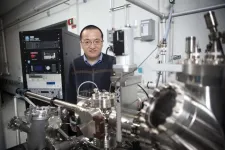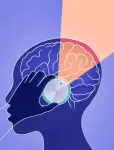(Press-News.org) BINGHAMTON, N.Y. -- When water vapor meets metal, the resulting corrosion can lead to mechanical problems that harm a machine’s performance. Through a process called passivation, it also can form a thin inert layer that acts as a barrier against further deterioration.
Either way, the exact chemical reaction is not well understood on an atomic level, but that is changing thanks to a technique called environmental transmission electron microscopy (TEM), which allows researchers to directly view molecules interacting on the tiniest possible scale.
Professor Guangwen Zhou — a faculty member at Binghamton University, State University of New York's Thomas J. Watson College of Engineering and Applied Science — has been probing the secrets of atomic reactions since joining the Department of Mechanical Engineering in 2007. Along with collaborators from the University of Pittsburgh and the Brookhaven National Laboratory, he has studied the structural and functional properties of metals and the process of making “green” steel.
Their latest research, “Atomistic mechanisms of water vapor induced surface passivation,” was published in November in the journal Science Advances. Co-authors included Binghamton PhD students Xiaobo Chen, Dongxiang Wu, Chaoran Li, Shuonan Ye and Shyam Bharatkumar Patel, MS ‘21; Na Cai, PhD ’12; Zhao Liu, PhD ’20; Weitao Shan, MS ’16, and Guofeng Wang from the University of Pittsburgh; and Sooyeon Hwang, Dmitri N. Zakharov and Jorge Anibal Boscoboinik from the Brookhaven National Laboratory.
In the paper, Zhou and his team introduced water vapor to clean aluminum samples and observed the surface reactions.
“This phenomenon is well-known because it happens in our daily lives,” he said. “But how do water molecules react with aluminum to form this passivation layer? If you look at the [research] literature, there’s not much work about how this happens at an atomic scale. If we want to use it for good, we must know, because then we will have some way to control it.”
They discovered something that had never been observed before: In addition to the aluminum hydroxide layer that formed on the surface, a second amorphous layer developed underneath it, which indicates there is a transport mechanism that diffuses oxygen into the substrate.
“Most corrosion studies focus on the growth of the passivation layer and how it slows down the corrosion process,” Zhou said. “To look at it from an atomic scale, we feel we can bridge the knowledge gap.”
The cost of repairing corrosion worldwide is estimated at $2.5 trillion a year, which is more than 3% of the global GDP — so developing better ways to manage oxidation would be an economic boon.
Additionally, understanding how a water molecule’s hydrogen and oxygen atoms break apart to interact with metals could lead to clean-energy solutions, which is why the U.S. Department of Energy funded this research and Zhou’s similar projects in the past.
“If you break water into oxygen and hydrogen, when you recombine it, it’s just water again,” he said. “It doesn’t have the contamination of fossil fuels, and it doesn’t produce carbon dioxide.”
Because of the clean-energy implications, the DOE regularly has renewed Zhou’s grant funding over the past 15 years.
“I greatly appreciate the long-term support for this research,” Zhou said. “It’s a very important issue for energy devices or energy systems, because you have a lot of metallic alloys that are used as structural material.”
END
How does corrosion happen? New research examines process on atomic level
Binghamton University collaboration with University of Pittsburgh, Brookhaven National Laboratory offers new a view of everyday chemical reaction
2024-01-03
ELSE PRESS RELEASES FROM THIS DATE:
Survival of the fittest: Words like 'Sex' and 'fight' are most likely to stand the test of time
2024-01-03
New research from the University of Warwick reveals that words like 'sex' endure in our language in a ‘survival of the fittest’ way, similar to natural selection.
Whilst the recent announcement of Word of the Year explores new words, like ‘rizz’ or ‘situationship’, Professor Thomas Hills’ research delves into why some words survive in our modern linguistic landscape, while others don’t.
The study concludes that words with the strongest lasting power are:
Words acquired earlier in life
Words associated with things people can see ...
NYU Grossman School of Medicine and Sarah Lawrence College launch graduate genomics degree program
2024-01-03
NYU Grossman School of Medicine’s Vilcek Institute of Graduate Biomedical Sciences and Sarah Lawrence College today announced the launch of a master’s program in genome health analysis (GHA).
Building on the strengths of both institutions, the new program will focus on analyses of patient genomes, the complete sets of genetic information in human cells. New tools have dramatically increased the amount and quality of genomic data available on each patient, but the field is constrained by the small number of experts trained to use and apply ...
Older adults with newly diagnosed migraine disorder three times more likely to have motor vehicle crash
2024-01-03
A new study from researchers at the University of Colorado Anschutz Medical Campus finds that older adult drivers who are recently diagnosed with migraines are three times as likely to experience a motor vehicle crash. Older adult drivers who reported having ever had migraines in the past were no more likely to have a motor vehicle crash than those without migraines.
Additionally, study results, published in the Journal of the American Geriatrics Society, explored the relationships medications commonly prescribed for migraine management have with increased crash risk.
“Migraine headaches affect ...
Researchers identify circulating proteins linked to preeclampsia and other hypertensive disorders of pregnancy
2024-01-03
BOSTON – Preeclampsia and other hypertensive disorders of pregnancy—which are characterized by high blood pressure with or without organ dysfunction during the second half of pregnancy—carry considerable short- and long-term risks for both the mother and child. Treatment options (other than expedited delivery) remain limited.
A team led by researchers at Massachusetts General Hospital (MGH) and the Broad Institute recently identified several proteins with strong evidence of causal or protective roles for hypertensive disorders of pregnancy, which could provide clues into how the conditions arise and how they might be prevented or treated.
In the study, which ...
New study taps artificial intelligence to streamline the crowdsourcing of ideas
2024-01-03
INFORMS Journal Marketing Science Study Key Takeaways:
Crowdsourcing generates thousands of ideas for new products.
AI can immediately help screen out bad ideas and narrow the field to the best ones in crowdsourcing to improve efficiency.
Ultimately, AI could identify the best ideas or even design good ideas.
BALTIMORE, MD, January 3, 2024 – New research has found a way to leverage the power of artificial intelligence (AI) to more efficiently screen out bad ideas to focus on only good ideas in the crowdsourcing process within ideation. More specifically, the research has arrived at a simple model ...
UH optometrist receives $1.4 million to map the cornea
2024-01-03
Consider the cornea if you will – and most people won’t unless they’re having a problem. It is the transparent front surface of the eye which allows vision by focusing light as it enters. The cornea is densely packed with multi-tasking nerves that mediate pain, blink reflexes and tear production, all indispensable tasks in the proper maintenance of ocular surface health. Because it is highly innervated, meaning it has a lot of nerve connections, the cornea is a key area for understanding sensory functions.
But ...
Researchers identify path to prevent cognitive decline after radiation
2024-01-03
Researchers at the Del Monte Institute for Neuroscience at the University of Rochester find that microglia—the brain’s immune cells—can trigger cognitive deficits after radiation exposure and may be a key target for preventing these symptoms. These findings, out today in the International Journal of Radiation Oncology Biology Biophysics, build on previous research showing that after radiation exposure microglia damage synapses, the connections between neurons that are important for cognitive ...
Mount Sinai study shows that human beliefs about drugs could have dose-dependent effects on the brain
2024-01-03
Mount Sinai researchers have shown for the first time that a person’s beliefs related to drugs can influence their own brain activity and behavioral responses in a way comparable to the dose-dependent effects of pharmacology.
The implications of the study, which directly focused on beliefs about nicotine, are profound. They range from elucidating how the neural mechanisms underlying beliefs may play a key role in addiction, to optimizing pharmacological and nonpharmacological treatments by leveraging the power of human beliefs. The study was published in the journal Nature Mental Health.
“Beliefs can have a powerful influence on our behavior, ...
Chronic childhood ear infections delay language development
2024-01-03
Ear infections are a common childhood experience, but a new study suggests parents should take these infections seriously to preserve their children’s language development. That’s because each ear infection can potentially impair hearing with fluid building up behind the eardrum.
New research from University of Florida scientists reveals that when ear infections become chronic, this repeated, temporary hearing loss can lead to deficits in auditory processing and language development in children years later.
“Ear ...
Inpatient costs of treating patients with COVID-19
2024-01-03
About The Study: In this study of more than 1.3 million inpatient admissions for treatment of COVID-19 from March 2020 through March 2022, researchers estimated an average national medical resource use or hospital cost to deliver care per COVID-19 inpatient stay at $11,275. Hospital costs increased more than five times the rate of medical inflation over this period. This was explained partly by changes in the use of extracorporeal membrane oxygenation, which also increased over time. Nonetheless, costs to provide inpatient care increased even as care practices changed, vaccination rates increased, and the variants of concern evolved.
Authors: Kandice A. ...
LAST 30 PRESS RELEASES:
Orthopedics can play critical role in identifying intimate partner violence
Worms as particle sweepers
Second spider-parasitic mite described in Brazil
January 2026 issues of APA journals feature new research on autism, pediatric anxiety, psychedelic therapy, suicide prevention and more
Private equity acquired more than 500 autism centers over the past decade, new study shows
New cervical cancer screening guidelines from the US Department of Health and Human Services
Estimated burden of COVID-19 illnesses, medical visits, hospitalizations, and deaths in the US from October 2022 to September 2024
Smartphone use during school hours by US youth
Food insecurity and adverse social conditions tied to increased risk of long COVID in children
Earliest, hottest galaxy cluster gas on record could change our cosmological models
Greenland’s Prudhoe Dome ice cap was completely gone only 7,000 years ago, first GreenDrill study finds
Scientific validity of blue zones longevity research confirmed
Injectable breast ‘implant’ offers alternative to traditional surgeries
Neuroscientists devise formulas to measure multilingualism
New prostate cancer trial seeks to reduce toxicity without sacrificing efficacy
Geometry shapes life
A CRISPR screen reveals many previously unrecognized genes required for brain development and a new neurodevelopmental disorder
Hot flush treatment has anti-breast cancer activity, study finds
Securing AI systems against growing cybersecurity threats
Longest observation of an active solar region
Why nail-biting, procrastination and other self-sabotaging behaviors are rooted in survival instincts
Regional variations in mechanical properties of porcine leptomeninges
Artificial empathy in therapy and healthcare: advancements in interpersonal interaction technologies
Why some brains switch gears more efficiently than others
UVA’s Jundong Li wins ICDM’S 2025 Tao Li Award for data mining, machine learning
UVA’s low-power, high-performance computer power player Mircea Stan earns National Academy of Inventors fellowship
Not playing by the rules: USU researcher explores filamentous algae dynamics in rivers
Do our body clocks influence our risk of dementia?
Anthropologists offer new evidence of bipedalism in long-debated fossil discovery
Safer receipt paper from wood
[Press-News.org] How does corrosion happen? New research examines process on atomic levelBinghamton University collaboration with University of Pittsburgh, Brookhaven National Laboratory offers new a view of everyday chemical reaction


